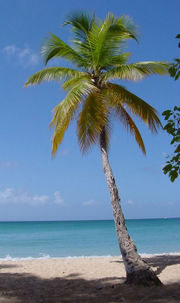Leaf

In botany, a leaf is an above-ground plant organ specialized for photosynthesis. For this purpose, a leaf is typically flat (laminar) and thin. As an evolutionary trait, the flatness of leaves works to expose the chloroplasts to more light and to increase the absorption of carbon dioxide at the expense of water loss. In the Devonian period, when carbon dioxide concentration was at several times its present value, plants did not have leaves or flat stems. Many bryophytes have flat, photosynthetic organs, but these are not true leaves. Neither are the microphylls of lycophytes. The leaves of ferns, gymnosperms, and angiosperms are variously referred to as macrophyll, megaphylls, or euphylls.
Leaves are also the sites in most plants where transpiration and guttation take place. Leaves can store food and water, and are modified in some plants for other purposes. The comparable structures of ferns are correctly referred to as fronds. Furthermore, leaves are prominent in the human diet as leaf vegetables.
Contents |
Anatomy
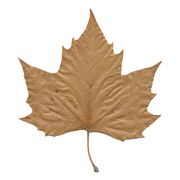

A structurally complete leaf of an angiosperm consists of a petiole (leaf stalk), a lamina (leaf blade), and stipules (small processes located to either side of the base of the petiole). The petiole attaches to the stem at a point called the "leaf axil." Not every species produces leaves with all of the aforementioned structural components. In certain species, paired stipules are not obvious or are absent altogether. A petiole may be absent, or the blade may not be laminar (flattened). The tremendous variety shown in leaf structure (anatomy) from species to species is presented in detail below under Leaf morphology. Periodically (i.e. seasonally, during the autumn), deciduous trees shed their leaves. These leaves then decompose into the soil.
A leaf is considered a plant organ and typically consists of the following tissues:
- An epidermis that covers the upper and lower surfaces
- An interior chlorenchyma called the mesophyll
- An arrangement of veins (the vascular tissue)
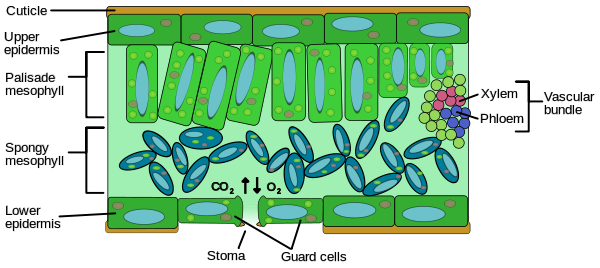
Epidermis
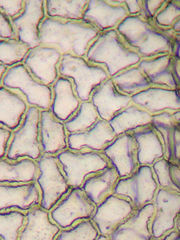
The epidermis is the outer layer of cells covering the leaf. It forms the boundary separating the plant's inner cells from the external world. The epidermis serves several functions: protection against water loss by way of transpiration, regulation of gas exchange, secretion of metabolic compounds, and (in some species) absorption of water. Most leaves show dorsoventral anatomy: the upper (adaxial) and lower (abaxial) surfaces have somewhat different construction and may serve different functions.
The epidermis is usually transparent (epidermal cells lack chloroplasts) and coated on the outer side with a waxy cuticle that prevents water loss. The cuticle is in some cases thinner on the lower epidermis than on the upper epidermis, and is thicker on leaves from dry climates as compared with those from wet climates.
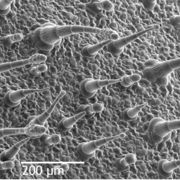
The epidermis tissue includes several differentiated cell types: epidermal cells, guard cells, subsidiary cells, and epidermal hairs (trichomes). The epidermal cells are the most numerous, largest, and least specialized. These are typically more elongated in the leaves of monocots than in those of dicots.
The epidermis is covered with pores called stomata, part of a stoma complex consisting of a pore surrounded on each side by chloroplast-containing guard cells, and two to four subsidiary cells that lack chloroplasts. The stoma complex regulates the exchange of gases and water vapor between the outside air and the interior of the leaf. Typically, the stomata are more numerous over the abaxial (lower) epidermis than the adaxial (upper) epidermis.
Mesophyll
Most of the interior of the leaf between the upper and lower layers of epidermis is a parenchyma (ground tissue) or chlorenchyma tissue called the mesophyll (Greek for "middle leaf"). This assimilation tissue is the primary location of photosynthesis in the plant. The products of photosynthesis are called "assimilates".

In ferns and most flowering plants the mesophyll is divided into two layers:
- An upper palisade layer of tightly packed, vertically elongated cells, one to two cells thick, directly beneath the adaxial epidermis. Its cells contain many more chloroplasts than the spongy layer. These long cylindrical cells are regularly arranged in one to five rows. Cylindrical cells, with the chloroplasts close to the walls of the cell, can take optimal advantage of light. The slight separation of the cells provides maximum absorption of carbon dioxide. This separation must be minimal to afford capillary action for water distribution. In order to adapt to their different environment (such as sun or shade), plants had to adapt this structure to obtain optimal result. Sun leaves have a multi-layered palisade layer, while shade leaves or older leaves closer to the soil, are single-layered.
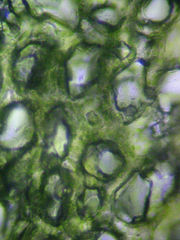
- Beneath the palisade layer is the spongy layer. The cells of the spongy layer are more rounded and not so tightly packed. There are large intercellular air spaces. These cells contain fewer chloroplasts than those of the palisade layer.
The pores or stomata of the epidermis open into substomatal chambers, connecting to air spaces between the spongy layer cells.
These two different layers of the mesophyll are absent in many aquatic and marsh plants. Even an epidermis and a mesophyll may be lacking. Instead for their gaseous exchanges they use a homogeneous aerenchyma (thin-walled cells separated by large gas-filled spaces). Their stomata are situated at the upper surface.
Leaves are normally green in color, which comes from chlorophyll found in plastids in the chlorenchyma cells. Plants that lack chlorophyll cannot photosynthesize.
Leaves in temperate, boreal, and seasonally dry zones may be seasonally deciduous (falling off or dying for the inclement season). This mechanism to shed leaves is called abscission. After the leaf is shed, a leaf scar develops on the twig. In cold autumns they sometimes change color, and turn yellow, bright orange or red as various accessory pigments (carotenoids and xanthophylls) are revealed when the tree responds to cold and reduced sunlight by curtailing chlorophyll production. Red anthocyanin pigments are now thought to be produced in the leaf as it dies, possibly to mask the yellow hue left when the chlorophyll is lost - yellow leaves appear to attract herbivores such as aphids.[1]
Veins

The veins are the vascular tissue of the leaf and are located in the spongy layer of the mesophyll. They are typical examples of pattern formation through ramification. The pattern of the veins is called venation.
The veins are made up of:
- Xylem: tubes that brings water and minerals from the roots into the leaf.
- Phloem: tubes that usually move sap, with dissolved sucrose, produced by photosynthesis in the leaf, out of the leaf.
The xylem typically lies over the phloem. Both are embedded in a dense parenchyma tissue, called "pith", with usually some structural collenchyma tissue present.
Morphology
.jpg)
External leaf characteristics (such as shape, margin, hairs, etc.) are important for identifying plant species, and botanists have developed a rich terminology for describing leaf characteristics. These structures are a part of what makes leaves determinant; they grow and achieve a specific pattern and shape, then stop. Other plant parts like stems or roots are non-determinant, and will usually continue to grow as long as they have the resources to do so.
Classification of leaves can occur through many different designative schema, and the type of leaf is usually characteristic of a species, although some species produce more than one type of leaf. The longest type of leaf is a leaf from palm trees, measuring at nine feet long. The terminology associated with the description of leaf morphology is presented, in illustrated form, at Wikibooks.
Basic types
.jpg)
- Ferns have fronds
- Conifer leaves are typically needle-, awl-, or scale-shaped
- Angiosperm (flowering plant) leaves: the standard form includes stipules, a petiole, and a lamina
- Lycophytes have microphyll leaves.
- Sheath leaves (type found in most grasses)
- Other specialized leaves (such as those of Nepenthes)
Arrangement on the stem
Different terms are usually used to describe leaf placement (phyllotaxis):

- Alternate — leaf attachments are singular at nodes, and leaves alternate direction, to a greater or lesser degree, along the stem.
- Opposite — Two structures, one on each opposite side of the stem, typically leaves, branches, or flower parts. Leaf attachments are paired at each node; decussate if, as typical, each successive pair is rotated 90° progressing along the stem; or distichous if not rotated, but two-ranked (in the same geometric flat-plane).
- Whorled — three or more leaves attach at each point or node on the stem. As with opposite leaves, successive whorls may or may not be decussate, rotated by half the angle between the leaves in the whorl (i.e., successive whorls of three rotated 60°, whorls of four rotated 45°, etc.). Opposite leaves may appear whorled near the tip of the stem.
- Rosulate — leaves form a rosette
As a stem grows, leaves tend to appear arranged around the stem in a way that optimizes yield of light. In essence, leaves form a helix pattern centred around the stem, either clockwise or counterclockwise, with (depending upon the species) the same angle of divergence. There is a regularity in these angles and they follow the numbers in a Fibonacci sequence: 1/2, 2/3, 3/5, 5/8, 8/13, 13/21, 21/34, 34/55, 55/89. This series tends to a limit close to 360° x 34/89 = 137.52 or 137° 30', an angle known mathematically as the golden angle. In the series, the numerator indicates the number of complete turns or "gyres" until a leaf arrives at the initial position. The denominator indicates the number of leaves in the arrangement. This can be demonstrated by the following:
- alternate leaves have an angle of 180° (or 1/2)
- 120° (or 1/3) : three leaves in one circle
- 144° (or 2/5) : five leaves in two gyres
- 135° (or 3/8) : eight leaves in three gyres.
Divisions of the blade

Two basic forms of leaves can be described considering the way the blade (lamina) is divided. A simple leaf has an undivided blade. However, the leaf shape may be formed of lobes, but the gaps between lobes do not reach to the main vein. A compound leaf has a fully subdivided blade, each leaflet of the blade separated along a main or secondary vein. Because each leaflet can appear to be a simple leaf, it is important to recognize where the petiole occurs to identify a compound leaf. Compound leaves are a characteristic of some families of higher plants, such as the Fabaceae. The middle vein of a compound leaf or a frond, when it is present, is called a rachis.
- Palmately compound leaves have the leaflets radiating from the end of the petiole, like fingers off the palm of a hand, e.g. Cannabis (hemp) and Aesculus (buckeyes).
- Pinnately compound leaves have the leaflets arranged along the main or mid-vein.
- odd pinnate: with a terminal leaflet, e.g. Fraxinus (ash).
- even pinnate: lacking a terminal leaflet, e.g. Swietenia (mahogany).
- Bipinnately compound leaves are twice divided: the leaflets are arranged along a secondary vein that is one of several branching off the rachis. Each leaflet is called a "pinnule". The pinnules on one secondary vein are called "pinna"; e.g. Albizia (silk tree).
- trifoliate (or trifoliolate): a pinnate leaf with just three leaflets, e.g. Trifolium (clover), Laburnum (laburnum).
- pinnatifid: pinnately dissected to the central vein, but with the leaflets not entirely separate, e.g. Polypodium, some Sorbus (whitebeams). In pinnately veined leaves the central vein in known as the midrib.
Characteristics of the petiole

Petiolated leaves have a petiole (leaf stem). Sessile leaves do not: the blade attaches directly to the stem. In clasping or decurrent leaves, the blade partially or wholly surrounds the stem, often giving the impression that the shoot grows through the leaf. When this is actually the case, the leaves are called "perfoliate", such as in Claytonia perfoliata. In peltate leaves, the petiole attaches to the blade inside from the blade margin.
In some Acacia species, such as the Koa Tree (Acacia koa), the petioles are expanded or broadened and function like leaf blades; these are called phyllodes. There may or may not be normal pinnate leaves at the tip of the phyllode.
A stipule, present on the leaves of many dicotyledons, is an appendage on each side at the base of the petiole resembling a small leaf. Stipules may be lasting and not be shed (a stipulate leaf, such as in roses and beans), or be shed as the leaf expands, leaving a stipule scar on the twig (an exstipulate leaf).
- The situation, arrangement, and structure of the stipules is called the "stipulation".
- free
- adnate : fused to the petiole base
- ochreate : provided with ochrea, or sheath-formed stipules, e.g. rhubarb,
- encircling the petiole base
- interpetiolar : between the petioles of two opposite leaves.
- intrapetiolar : between the petiole and the subtending stem
Venation

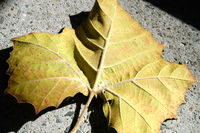
There are two subtypes of venation, namely, craspedodromous, where the major veins stretch up to the margin of the leaf, and camptodromous, when major veins extend close to the margin, but bend before they intersect with the margin.
- Feather-veined, reticulate — the veins arise pinnately from a single mid-vein and subdivide into veinlets. These, in turn, form a complicated network. This type of venation is typical for (but by no means limited to) dicotyledons.
- Pinnate-netted, penniribbed, penninerved, penniveined; the leaf has usually one main vein (called the mid-vein), with veinlets, smaller veins branching off laterally, usually somewhat parallel to each other; e.g. Malus (apples).
- Three main veins branch at the base of the lamina and run essentially parallel subsequently, as in Ceanothus. A similar pattern (with 3-7 veins) is especially conspicuous in Melastomataceae.
- Palmate-netted, palmate-veined, fan-veined; several main veins diverge from near the leaf base where the petiole attaches, and radiate toward the edge of the leaf; e.g. most Acer (maples).
- Parallel-veined, parallel-ribbed, parallel-nerved, penniparallel — veins run parallel for the length of the leaf, from the base to the apex. Commissural veins (small veins) connect the major parallel veins. Typical for most monocotyledons, such as grasses.
- Dichotomous — There are no dominant bundles, with the veins forking regularly by pairs; found in Ginkgo and some pteridophytes.
Note that although it is the more complex pattern, branching veins appear to be plesiomorphic and in some form were present in ancient seed plants as long as 250 million years ago. A pseudo-reticulate venation that is actually a highly modified penniparallel one is an autapomorphy of some Melanthiaceae which are monocots, e.g. Paris quadrifolia (True-lover's Knot).
Morphology changes within a single plant
- Homoblasty - Characteristic in which a plant has small changes in leaf size, shape, and growth habit between juvenile and adult stages.
- Heteroblasty - Characteristic in which a plant has marked changes in leaf size, shape, and growth habit between juvenile and adult stages.
Terminology

Shape
Edge
- ciliate: fringed with hairs
- crenate: wavy-toothed; dentate with rounded teeth, such as Fagus (beech)
- crenulate finely or shallowly crenate
- dentate: toothed, such as Castanea (chestnut)
- coarse-toothed: with large teeth
- glandular toothed: with teeth that bear glands.
- denticulate: finely toothed
- doubly toothed: each tooth bearing smaller teeth, such as Ulmus (elm)
- entire: even; with a smooth margin; without toothing
- lobate: indented, with the indentations not reaching to the center, such as many Quercus (oaks)
- palmately lobed: indented with the indentations reaching to the center, such as Humulus (hop).
- serrate: saw-toothed with asymmetrical teeth pointing forward, such as Urtica (nettle)
- serrulate: finely serrate
- sinuate: with deep, wave-like indentations; coarsely crenate, such as many Rumex (docks)
- spiny: with stiff, sharp points, such as some Ilex (hollies) and Cirsium (thistles).
Tip

- acuminate: long-pointed, prolonged into a narrow, tapering point in a concave manner.
- acute: ending in a sharp, but not prolonged point
- cuspidate: with a sharp, elongated, rigid tip; tipped with a cusp.
- emarginate: indented, with a shallow notch at the tip.
- mucronate: abruptly tipped with a small short point, as a continuation of the midrib; tipped with a mucro.
- mucronulate: mucronate, but with a smaller spine.
- obcordate: inversely heart-shaped, deeply notched at the top.
- obtuse: rounded or blunt
- truncate: ending abruptly with a flat end, that looks cut off.
Base
- acuminate: coming to a sharp, narrow, prolonged point.
- acute: coming to a sharp, but not prolonged point.
- auriculate: ear-shaped.
- cordate: heart-shaped with the notch towards the stalk.
- cuneate: wedge-shaped.
- hastate: shaped like an halberd and with the basal lobes pointing outward.
- oblique: slanting.
- reniform: kidney-shaped but rounder and broader than long.
- rounded: curving shape.
- sagittate: shaped like an arrowhead and with the acute basal lobes pointing downward.
- truncate: ending abruptly with a flat end, that looks cut off.
Surface
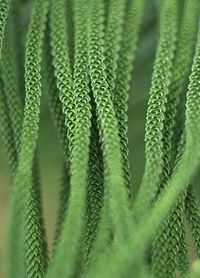
- farinose: bearing farina; mealy, covered with a waxy, whitish powder.
- glabrous: smooth, not hairy.
- glaucous: with a whitish bloom; covered with a very fine, bluish-white powder.
- glutinous: sticky, viscid.
- papillate, or papillose: bearing papillae (minute, nipple-shaped protuberances).
- pubescent: covered with erect hairs (especially soft and short ones).
- punctate: marked with dots; dotted with depressions or with translucent glands or colored dots.
- rugose: deeply wrinkled; with veins clearly visible.
- scurfy: covered with tiny, broad scalelike particles.
- tuberculate: covered with tubercles; covered with warty prominences.
- verrucose: warted, with warty outgrowths.
- viscid, or viscous: covered with thick, sticky secretions.
The leaf surface is also host to a large variety of microorganisms; in this context it is referred to as the phyllosphere.
Hairiness


"Hairs" on plants are properly called trichomes. Leaves can show several degrees of hairiness. The meaning of several of the following terms can overlap.
- arachnoid, or arachnose: with many fine, entangled hairs giving a cobwebby appearance.
- barbellate: with finely barbed hairs (barbellae).
- bearded: with long, stiff hairs.
- bristly: with stiff hair-like prickles.
- canescent: hoary with dense grayish-white pubescence.
- ciliate: marginally fringed with short hairs (cilia).
- ciliolate: minutely ciliate.
- floccose: with flocks of soft, woolly hairs, which tend to rub off.
- glabrous: no hairs of any kind present.
- glandular: with a gland at the tip of the hair.
- hirsute: with rather rough or stiff hairs.
- hispid: with rigid, bristly hairs.
- hispidulous: minutely hispid.
- hoary: with a fine, close grayish-white pubescence.
- lanate, or lanose: with woolly hairs.
- pilose: with soft, clearly separated hairs.
- puberulent, or puberulous: with fine, minute hairs.
- pubescent: with soft, short and erect hairs.
- scabrous, or scabrid: rough to the touch.
- sericeous: silky appearance through fine, straight and appressed (lying close and flat) hairs.
- silky: with adpressed, soft and straight pubescence.
- stellate, or stelliform: with star-shaped hairs.
- strigose: with appressed, sharp, straight and stiff hairs.
- tomentose: densely pubescent with matted, soft white woolly hairs.
- cano-tomentose: between canescent and tomentose.
- felted-tomentose: woolly and matted with curly hairs.
- villous: with long and soft hairs, usually curved.
- woolly:' with long, soft and tortuous or matted hairs.
Adaptations
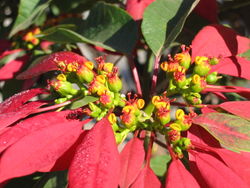
In the course of evolution, leaves have adapted to different environments in the following ways:
- A certain surface structure avoids moistening by rain and contamination (See Lotus effect).
- Sliced leaves reduce wind resistance.
- Hairs on the leaf surface trap humidity in dry climates and create a large boundary layer thereby reducing water loss.
- Waxy leaf surfaces reduce water loss.
- Large surface area of leaf provides large area for sunlight and provides shade for plant to minimize heating and reduce water loss.
- In more or less opaque or buried in the soil leaves, translucent windows filter the light before the photosynthesis takes place at the inner leaf surfaces (e.g. Fenestraria).
- Succulent leaves store water and organic acids for use in CAM photosynthesis.
- Aromatic oils, poisons or pheromones produced by leaf borne glands deter herbivores (e.g. eucalypts).
- Inclusions of crystalline minerals deter herbivores (e.g. silica in grasses.
- A transformation into petals attracts pollinators.
- A transformation into spines protects the plants (e.g. cacti).
- A transformation into insect traps helps feeding the plants (carnivorous plants).
- A transformation into bulbs helps storing food and water (e.g. onions).
- A transformation into tendrils allows the plant to climb (e.g. peas).
- A transformation into bracts and pseudanthia (false flowers) replaces normal flower structures if the true flowers are extremely reduced (e.g. Spurges).
Interactions with other organisms
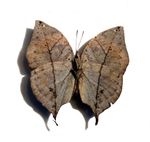

Although not as nutritious as other organs such as fruit, leaves provide a food source for many organisms. Animals which eat leaves are known as folivores. The leaf is one of the most vital parts of the plant, and plants have evolved protection against folivores such as tannins, chemicals which hinder the digestion of proteins and have an unpleasant taste.
Some animals have cryptic adaptations to avoid their own predators. For example, some caterpillars will create a small home in the leaf by folding it over themselves, while other herbivores and their prey mimic the appearance of the leaf. Some insects, such as the katydid, take this even further, moving from side to side much like a leaf does in the wind.
Bibliography
- Leaves: The formation, charactistics and uses of hundred of leaves in all parts of the world by Ghillean Tolmie Prance. 324 photographic plates in black and white, and colour by Kjell B Sandved 256 pages[2]
Footnotes
- ↑ Thomas F. Döring; Marco Archetti; Jim Hardie (2009), "Autumn leaves seen through herbivore eyes" (– Scholar search), Proceedings of the Royal Society B Biological Sciences 276 (1654): 121, doi:10.1098/rspb.2008.0858, PMID 18782744, PMC 2614250, http://users.ox.ac.uk/~zool0643/papers/PRSB_2008_silwood.pdf
- ↑ Published by Thames and Hudson (London) with an ISBN 0 500 54104 3
See also
- Abscission (losing of leaves)
- Cladophyll
- Guttation (beads of fluid forming at leaf margins)
- Leaf area index
- Phylloclade
- Vernation (sprouting of leaves)
- Evolution of leaves
- Leaf protein concentrate
External links
- VASCULAR PLANT SYSTEMATICS Section B. General Characters and Character States: Position and Arrangement
- Science aid: Leaf Leaf structure and transpiration resource for teens.
|
|||||||||||||||||||||||||||||
